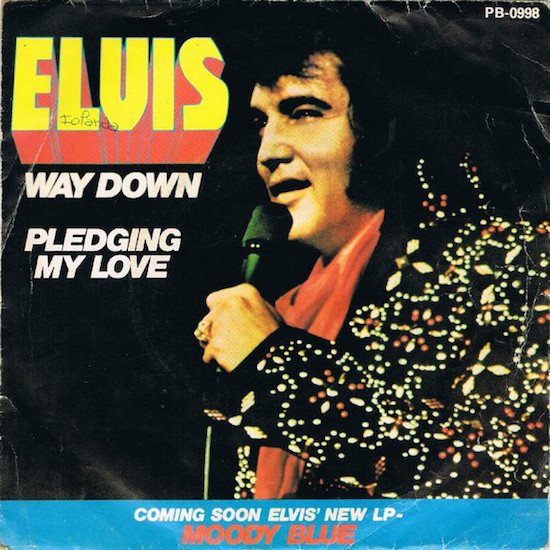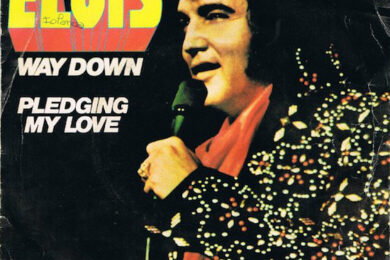My copy of Elvis Presley’s The 50 Greatest Hits doesn’t get played very often. In fact, it really only gets a spin on Christmas Day, somewhere between Frank Sinatra’s Twenty Golden Greats and a four-CD box set of Remember Then: Vocal Group Classics From The Doo Wop Era. Yet it contains multitudes. A double CD, bought around the turn of the millennium, it traces Elvis’s career chronologically, from the explosive young rebel forging a shocking new hybrid of country and R&B in the mid-50s with ‘That’s All Right’ and ‘Mystery Train’, to unassailable rock & roll touchstones such as ‘Hound Dog’ and ‘Jailhouse Rock’, and through subsequent years of superstardom all the way up to the sad dissolution of his powers, fizzling out with the last single released in his lifetime, 1977’s ‘Way Down’.
Whichever way you slice it – and especially compared to the eternal triumphs that precede it – ‘Way Down’ is a clunker. The final song on the second CD, it’s a strangely anticlimactic end to the collection, and painfully emblematic of the tragic conclusion to Elvis’s almost mythologically resonant tale of consuming fame and failure. But, more than that, due to a complex tangle of dim childhood memories and sociohistorical circumstance, in my mind, it represents something far deeper and more profound: it’s a reminder of the fragility of existence, a trigger signal for the uncanny and unexplained, and a harbinger of cosmic entropy.
‘Way Down’ was recorded at home in Elvis’s Graceland mansion in 1976. Much to his label RCA’s chagrin, he’d spent just a handful of days in a recording studio in 74 and 75 and showed little enthusiasm for returning any time soon. RCA’s solution was to bring the studio to him, setting up a mobile facility in his garishly decorated, tiki-themed den, built as an annexe at the rear of Graceland in 1965, and later nicknamed the Jungle Room. Two recording sessions took place there in 1976. Six nights in February yielded his penultimate album From Elvis Presley Boulevard, Memphis, Tennessee, released later that year. Two more nights of recording in October generated about half of the tracks included on his final album, 1977’s Moody Blue. ‘Way Down’ was recorded during this last session, on 29 October.
Elvis was 41 years old and in extremely bad shape. Years of addiction to prescription drugs and high-fat binge-eating had ravaged his body. He was suffering from diabetes, glaucoma and hypertension. He had an enlarged heart and was chronically constipated. It’s no surprise that his performance on ‘Way Down’ sounds tired and uninspired, with little of the smouldering magnetism of previous years. The song itself, written by Layng Martine Jr, feels jarringly unsuitable for a performer long past his heyday as a sex symbol, and lyrically suspect on so many levels. (Let’s not even dwell on the song’s title and lines such as “Way down where it feels so good / Way down where I hoped it would / Way down where I never could.”) In the opening verse, Elvis’s attempt to sound seductive comes across instead as if he’s succumbing to unconsciousness as he sings:
“Babe, you’re getting closer
The lights are goin’ dim
The sound of your breathin
Made the mood I’m in
All of my resistance
Lyin’ on the floor
Taking me to places
I’ve never been before.”
Perhaps most off-key, given Elvis’s hopelessly damaging abuse of barbiturates, amphetamines and opioids prescribed by his personal physician, George Nichopoulos – aka Dr Nick – are the lines:
“The medicine within me
No doctor could prescribe
Your love is doing something
That I just can’t describe.”
Sex, drugs and rock ’n’ roll never sounded so unappealing.
Musically, ‘Way Down’ is not much more convincing. It begins with a low synthesizer throb (weirdly reminiscent of the theme to Doctor Who) and a slippery electric bass guitar signalling slick modernity, before settling into a lumpen rock beat with drums and piano, then erupting into a jaunty rock & roll chorus with female backing vocals adding a gospel-tinged coda. Its most distinctive feature is the phrase “way on down”, sung at the end of each chorus in a sepulchral low C by JD Sumner. Active since the…



